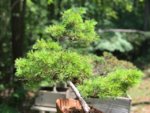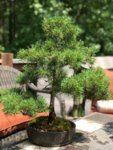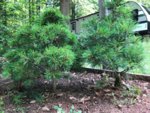FoldedFrog
Mame
Hi,
Just thought I would give an update on what is now a nine year experiment with working with Japanese white pines in the south. As I'm sure most people know, these mountain pines really don't like heat and humidity. I feel that enough time has passed that I may share some of my experience and some success.
First, a little background: I responded to a Craigslist ad in 2010 where a very nice Vietnamese gentleman in north Georgia was selling both Japanese White and Black pines that were about 15 years old. He was planning a big move and had to get rid of them. I considered it a gold mine since he sold the trees to me at an average price of about $15 each. I got six Japanese White Pines and four or five blacks from him. These were all in nursery pots and he had done some ititial styling and wiring on the trees. Couldn't pass it up! It should be said that I live about 35 miles south of Atlanta Georgia (Coweta County if it helps) and being concerned about the about the obvious pitfalls of trying to raise them here, I talked with Brent Walston to get some advice. He was kind enough to share a myriad of advice and, I must say, it appears to be working out.
Now for my experience base on Brent's input:
First of all, I think that it helps that these trees were relatively young and acclimated to a somewhat milder, north Georgia climate (just above Lake Lanier in the Appalachian hills). He didn't seem to be too concerned about over-watering even though these trees were not grafted and on their own roots. I was concerned because the soil was highly water retentive and wanted to get them into some well draining soil. I decided to do a fall repot - first mistake! Although I was very careful, two of the Whites died the next spring. I, personally, will not do a fall repot on a JWP again. As for the others, they faired well and have done very nicely with spring repots since.
The second thing that has seemed to work very well is keeping the JWP roots from overheating. No black plastic pots of course and NO AFTERNOON SUN! I did an experiment in late summer to test the difference in soil temperature using a light colored pot in the afternoon shade versus the same soil in a black pot in afternoon sunlight. The first pot's soil never got above 94 degrees whiIe the full-sun black pot soil reached a scorching 122 degrees! I know it is a sacrifice to shorten the direct sun but this ain't Alaska and it is necessary if you are going to be successful. I initially placed them all along a western woodline on the edge of my property. They receive mottled shade after 1:00 PM. Before that, they get full sun from about 8:30AM. They all seem very pleased with this arrangement.
For the last few years I have even relocated two of them and planted them in the ground. I achieved this by employing an old 4' X 8' wooden box garden that was filled with top soil. Under the advice of Mr Walston, I didn't want to plant them in GA red clay. It is way too water retentive. This light soil seems to accomodate them very well. Additionally, I built a small arbor and covered it with shade cloth. More accurately, I use open burlap landscape fabric from HD. The burlap is positioned directly over the pines and it hangs down on the west side of the arbor to protect from the late sun. They are shaded by the burlap for the majority of the time during the summer days. The arbor is open to the south so, as the sun lowers in the sky in the fall and becomes less intense, they receive more and more direct sun as it gets cooler. There are pictures below of the ones in the ground also.
Finally, as to the frigid Georgia winters! In the winter we barely break 1000 chill hours here. For this reason, my JWP's in pots never see the direct sun. I place them near the northern wall of my two-story house just out of line with the sun. When they look up in the winter, they see lots of clear blue sky but not the sun. This also provides for a lot of heat loss at night as there are no big trees above. I believe this keeps them as cool for as long as possible each day and provides plenty of reflected sunlight from the atmosphere while they are dormant. I have yet to bring them shelter, no matter how cold it has gotten, even single digits F.
In the winter we barely break 1000 chill hours here. For this reason, my JWP's in pots never see the direct sun. I place them near the northern wall of my two-story house just out of line with the sun. When they look up in the winter, they see lots of clear blue sky but not the sun. This also provides for a lot of heat loss at night as there are no big trees above. I believe this keeps them as cool for as long as possible each day and provides plenty of reflected sunlight from the atmosphere while they are dormant. I have yet to bring them shelter, no matter how cold it has gotten, even single digits F.
Well, that's pretty much my experience. I hope this gives some hope that us southern folk can play around with JWP's. I'm NOT saying that anything further south, or with older trees, or with imported tress will be successful (although there is a 100+ year old JWP at the Monastery of the Holy Spirit in Conyers GA).



Just thought I would give an update on what is now a nine year experiment with working with Japanese white pines in the south. As I'm sure most people know, these mountain pines really don't like heat and humidity. I feel that enough time has passed that I may share some of my experience and some success.
First, a little background: I responded to a Craigslist ad in 2010 where a very nice Vietnamese gentleman in north Georgia was selling both Japanese White and Black pines that were about 15 years old. He was planning a big move and had to get rid of them. I considered it a gold mine since he sold the trees to me at an average price of about $15 each. I got six Japanese White Pines and four or five blacks from him. These were all in nursery pots and he had done some ititial styling and wiring on the trees. Couldn't pass it up! It should be said that I live about 35 miles south of Atlanta Georgia (Coweta County if it helps) and being concerned about the about the obvious pitfalls of trying to raise them here, I talked with Brent Walston to get some advice. He was kind enough to share a myriad of advice and, I must say, it appears to be working out.
Now for my experience base on Brent's input:
First of all, I think that it helps that these trees were relatively young and acclimated to a somewhat milder, north Georgia climate (just above Lake Lanier in the Appalachian hills). He didn't seem to be too concerned about over-watering even though these trees were not grafted and on their own roots. I was concerned because the soil was highly water retentive and wanted to get them into some well draining soil. I decided to do a fall repot - first mistake! Although I was very careful, two of the Whites died the next spring. I, personally, will not do a fall repot on a JWP again. As for the others, they faired well and have done very nicely with spring repots since.
The second thing that has seemed to work very well is keeping the JWP roots from overheating. No black plastic pots of course and NO AFTERNOON SUN! I did an experiment in late summer to test the difference in soil temperature using a light colored pot in the afternoon shade versus the same soil in a black pot in afternoon sunlight. The first pot's soil never got above 94 degrees whiIe the full-sun black pot soil reached a scorching 122 degrees! I know it is a sacrifice to shorten the direct sun but this ain't Alaska and it is necessary if you are going to be successful. I initially placed them all along a western woodline on the edge of my property. They receive mottled shade after 1:00 PM. Before that, they get full sun from about 8:30AM. They all seem very pleased with this arrangement.
For the last few years I have even relocated two of them and planted them in the ground. I achieved this by employing an old 4' X 8' wooden box garden that was filled with top soil. Under the advice of Mr Walston, I didn't want to plant them in GA red clay. It is way too water retentive. This light soil seems to accomodate them very well. Additionally, I built a small arbor and covered it with shade cloth. More accurately, I use open burlap landscape fabric from HD. The burlap is positioned directly over the pines and it hangs down on the west side of the arbor to protect from the late sun. They are shaded by the burlap for the majority of the time during the summer days. The arbor is open to the south so, as the sun lowers in the sky in the fall and becomes less intense, they receive more and more direct sun as it gets cooler. There are pictures below of the ones in the ground also.
Finally, as to the frigid Georgia winters!
Well, that's pretty much my experience. I hope this gives some hope that us southern folk can play around with JWP's. I'm NOT saying that anything further south, or with older trees, or with imported tress will be successful (although there is a 100+ year old JWP at the Monastery of the Holy Spirit in Conyers GA).



